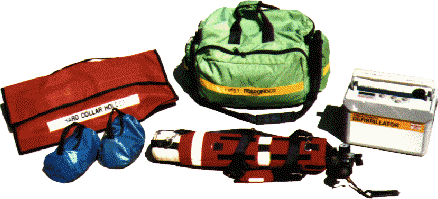|
*Technical Stuff
Compartment A
Aluminum Clipboard (with a notepad)
FR Forms
Pens
Pocket masks w/one-way valves
Bag-valve-mask reservoir (BVM)
Child Bag-valve-mask, mask
Set oropharyngeal airways (8 in each set)
V-Vac Unit and tip
Standard adult O2 masks
Standard child O2 masks
Non-rebreather adult O2 masks
Non-rebreather child O2 mask
Rolls/coils O2 tubing
500ml bottle Saline w/ eye sleeves
Med. burn pack or Burn blanket
12" x 12" Polygauze
18" x 18" Polygauze
36" x 36" Polygauze
Alcare Foamed or Gel alcohol

Compartment B
Pressure Dressings
8" x 10" ABD Pads
6" x 8" or 5" x 9" ABD Pads
10" x 30" Multi-trauma
3" cling (cotton) bandage
3" crepe (tensor) bandage
1" cloth tape
1" Transpor (hypoallergenic)
Zip-lock bag of 4" x 4" Gauze pads
4" x 4" Gauze pads / Sponges
3" x 4" Telfa or Melolite pads
Esmarch (occlusive dressing)
Zip-lock Mixed Band-aids

Compartment C
Ring pad
Triangular Bandages
SAM Splints
Hot Packs
Cold Packs

Compartment D
Pairs Med. Surgical Gloves (Non-Sterile)
Pairs Surgical Gloves (Sterile)
Surgical masks
Pair of safety goggles
Tongue Depressors
Glucopaks
O2 Wrench (spare)

Compartment E
Pair Scissors
Pen light
Pen (spare)
Zap Straps / Speed Straps
500ml Savlodil bottle (with spray nozzle)

|  |


